Joint Evaluation of the Wave and Offshore Wind Energy Resources in the Developing Countries
Abstract
1. Introduction
- Assessment of the energy budget reported for several developing countries, by taking into account the processes that are related to the fossil fuel consumption and the interest of these countries for the renewable energy projects;
- A better understanding of the global wind and wave conditions from a meteorological point of view by taking into account fifteen different references sites. In this case will be evaluated the monthly, seasonal and inter-annual variations;
- Establish the energy profile of each site by using specific parameters;
- Identify the performances of some common offshore wind turbines, which may operate in these coastal environments.
2. Methods and Materials
2.1. The Target Areas
2.2. ERA-Interim Global Wind and Wave Data
3. Results
3.1. Analysis of the Wind Conditions
3.2. Analysis of the Wave Conditions
4. Discussion of the Results
5. Conclusions
- throughout a literature review, the energy market and the progress of the renewable industry were identified for each target area. For the regions that are not included in the Global Statistical report [71], the associated values can be considered as an optimistic indicator;
- more promising sites in terms of the wind resources were identified, which are close to: AM3 (Chile), AF5 (Somalia), AS5 (Russia), AS2 (Vietnam), and AF3 (South Africa), respectively;
- lower wind resources are noticed close to: AF4 (Madagascar), AF1 (Guinea-Bissau), AS3 (Timor), AF2 (Angola), AM1 (Mexico), and AS4 (Papua New Guinea), respectively. This means that it will not be viable to develop an offshore wind project near these sites; and,
- the best performances of a wind turbine are expected to be registered close to the site AM3. In this case a rated capacity of 50% was obtained, which means that the generator will operate at full capacity at least 50% from the time interval considered for evaluation.
- in terms of the wave energy most of the sites present values located in the classes C1, C2, and C3, which are considered to be moderate;
- the best performances of a wave farm are expected to be obtained near the sites AM3 (Chile) and AF3 (South Africa). Since the wind and waves are more powerful close to these areas, it can be expected that a joint wind-wave project will be more successful in these two coastal environments;
- in general, the inter-annual variations of the Hs parameter exceed the monthly variations;
- on a global scale, the AS group sites present more significant monthly variations of the wave heights; and,
- a classification of the sites, according to their wind and wave height was represented by taking into account the normalized values.
Acknowledgments
Author Contributions
Conflicts of Interest
References
- Best, R.; Burke, P.J. The importance of government effectiveness for transitions toward greater electrification in developing countries. Energies 2017, 10, 1247. [Google Scholar] [CrossRef]
- Martinez, M.L.; Intralawan, A.; Vazquez, G.; Perez-Maqueo, O.; Sutton, P.; Landgrave, R. The coasts of our world: Ecological, economic and social importance. Ecol. Econ. 2007, 63, 254–272. [Google Scholar] [CrossRef]
- Amadi, H.N. Impact of Power Outages on Developing Countries: Evidence from Rural Households in Niger Delta, Nigeria. J. Energy Technol. Policy 2015, 5, 27–38. [Google Scholar]
- Gallup, J.L. Geography and Socioeconomic Development in Latin America and the Caribbean; Chapter 3 of Economic and Social Progress in Latin America, 1999–2000 Report; Inter-American Development Bank: Washington, DC, USA, 2000. [Google Scholar]
- U.S. Army Corps of Engineers. Coastal Engineering Manual; EM 1110-2-1100; U.S. Army Corps of Engineers: Washington, DC, USA, 2008.
- Perez-Collazo, C.; Greaves, D.; Iglesias, G. A review of combined wave and offshore wind energy. Renew. Sustain. Energy Rev. 2015, 42, 141–153. [Google Scholar] [CrossRef]
- Astariz, S.; Iglesias, G. Enhancing wave energy competitiveness through co-located wind and wave energy farms. A review on the shadow effect. Energies 2015, 8, 7344–7366. [Google Scholar] [CrossRef]
- Karimirad, M.; Koushan, K. WindWEC: Combining wind and wave energy inspired by hywind and wavestar. In Proceedings of the 2016 IEEE International Conference on Renewable Energy Research and Applications (ICRERA), Birmingham, UK, 20–23 November 2016. [Google Scholar] [CrossRef]
- Marzband, M.; Parhizi, N.; Savaghebi, M.; Guerrero, J.M. Distributed Smart Decision-Making for a Multi-microgrid System Based on a Hierarchical Interactive Architecture. IEEE Trans. Energy Convers. 2016, 31, 637–648. [Google Scholar] [CrossRef]
- Marzband, M.; Azarinejadian, F.; Savagheb, M.; Guerrero, J.M. An optimal energy management system for islanded microgrids based on multiperiod artificial bee colony combined with Markov Chain. IEEE Syst. J. 2015, 11, 1712–1722. [Google Scholar] [CrossRef]
- Marzband, M.; Sumper, A.; Ruiz-Alvareza, A.; Dominguez-Garcia, J.L.; Tomoiaga, B. Experimental evaluation of a real time energy management system for stand-alone microgrids in dayahead markets. Appl. Energy 2013, 106, 365–376. [Google Scholar] [CrossRef]
- Rusu, E.; Onea, F. Estimation of the wave energy conversion efficiency in the Atlantic Ocean close to the European islands. Renew. Energy 2016, 85, 687–703. [Google Scholar] [CrossRef]
- Marzband, M.; Javadi, M.; Dominguez-Garcia, J.L.; Moghaddam, M.M. Non-cooperative game theory based energy management systems for energy district in the retail market considering DER uncertainties. IET Gener. Transm. Distrib. 2016, 10, 2999–3009. [Google Scholar] [CrossRef]
- Valinejad, J.; Marzband, M.; Akorede, M.; Barforoshi, T.; Jovanovic, M. Generation expansion planning in electricity market considering uncertainty in load demand and presence of strategic GENCOs. Electr. Power Syst. Res. 2017, 152, 92–104. [Google Scholar] [CrossRef]
- Hanley, K.E.; Belcher, S. A global climatology of wind–wave interaction. J. Phys. Oceanogr. 2010, 40, 1263–1282. [Google Scholar] [CrossRef]
- Reguero, B.G.; Menendez, M.; Mendez, F.J.; Minguez, R.; Losada, I.J. A Global Ocean Wave (GOW) calibrated reanalysis from 1948 onwards. Coast. Eng. 2012, 65, 38–55. [Google Scholar] [CrossRef]
- Mentaschi, L.; Vousdoukas, M.I.; Voukouvalas, E.; Dosio, A.; Feyen, L. Global changes of extreme coastal wave energy fluxes triggered by intensified teleconnection pattern. Geophys. Res. Lett. 2016, 44, 2416–2426. [Google Scholar] [CrossRef]
- Rusu, L.; Onea, F. The performances of some state of the art wave energy converters in locations with the worldwide highest wave power. Renew. Sustain. Energy Rev. 2017, 75, 1348–1362. [Google Scholar] [CrossRef]
- Iglesias, G.; Carballo, R. Wave energy and nearshore hot spots: The case of the SE Bay of Biscay. Renew. Energy 2010, 35, 2490–2500. [Google Scholar] [CrossRef]
- Global Wind Energy Council (GWEC). Global Wind Energy Outlook; GWEC: Brussels, Belgium, 2016. [Google Scholar]
- United Nations Environment Programme. Renewable Energy and Energy Efficiency in Developing Countries: Contributions to Reducing Global Emissions; Second Report 2016; United Nations Environment Programme: Nairobi, Kenya, 2016. [Google Scholar]
- United Nations Development Programme (UNDP). Human Development Report 2015: Work for Human Development; UNDP: New York, NY, USA, 2015; ISBN 978-92-1-126398-5. [Google Scholar]
- Johnston, R.B.; Berg, M.; Johnson, C.A.; Tilley, E.; Hering, J.G. Water and Sanitation in Developing Countries: Geochemical Aspects of Quality and Treatment. Elements 2011, 7, 163–168. [Google Scholar] [CrossRef]
- Eurek, K.; Sullivan, P.; Gleason, M.; Hettinger, D.; Heimiller, D.; Lopez, A. An improved global wind resource estimate for integrated assessment models. Energy Econ. 2017, 64, 552–567. [Google Scholar] [CrossRef]
- Lu, X.; McElroy, M.B.; Kiviluoma, J. Global potential for wind-generated electricity. Proc. Natl. Acad. Sci. USA 2009, 106, 10933–10938. [Google Scholar] [CrossRef] [PubMed]
- Hemer, M.A.; Trenham, C.E. Evaluation of a CMIP5 derived dynamical global wind wave climate model ensemble. Ocean Model. 2016, 103, 190–203. [Google Scholar] [CrossRef]
- Stopa, J.E.; Cheung, K.F. Periodicity and patterns of ocean wind and wave climate. J. Geophys. Res. Oceans 2014, 119, 5563–5584. [Google Scholar] [CrossRef]
- Dobrynin, M.; Murawsky, J.; Yang, S. Evolution of the global wind wave climate in CMIP5 experiments. Geophys. Res. Lett. 2012, 39, L18606. [Google Scholar] [CrossRef]
- Jiang, H.; Chen, G. A global view on the swell and wind sea climate by the Jason-1 mission: A revisit. J. Atmos. Ocean. Technol. 2013, 30, 1833–1841. [Google Scholar] [CrossRef]
- Semedo, A.; Susel, K.; Rutgersson, A.; Sterl, A. A global view on the wind sea and swell climate and variability from ERA-40. J. Clim. 2011, 24, 1461–1479. [Google Scholar] [CrossRef]
- Emmanouil, G.; Galanis, G.; Kalogeri, C.; Zodiatis, G.; Kallos, G. 10-year high resolution study of wind, sea waves and wave energy assessment in the Greek offshore areas. Renew. Energy 2016, 90, 399–419. [Google Scholar] [CrossRef]
- Foti, E.; Musumeci, R.; Leanza, S.; Cavallaro, L. Feasibility of an offshore wind farm in the gulf of Gela: Marine and structural issues. Wind Eng. 2010, 34, 65–84. [Google Scholar] [CrossRef]
- Omrani, H.; Drobinski, P.; Arsouze, T.; Bastin, S.; Lebeaupin-Brossier, C.; Mailler, S. Spatial and temporal variability of wind energy resource and production over the north western Mediterranean sea: Sensitivity to air-sea interactions. Renew. Energy 2017, 101, 680–689. [Google Scholar] [CrossRef]
- Soukissian, T.; Karathanasi, F.; Axaopoulos, P. Satellite-based offshore wind resource assessment in the mediterranean sea. IEEE J. Ocean. Eng. 2017, 42, 73–86. [Google Scholar] [CrossRef]
- Onea, F.; Deleanu, L.; Rusu, L.; Georgescu, C. Evaluation of the wind energy potential along the Mediterranean Sea coasts. Energy Explor. Exploit. 2016, 34, 766–792. [Google Scholar] [CrossRef]
- Guedes Soares, C.; Bento, A.R.; Gonçalves, M.; Silva, D.; Martinho, P. Numerical evaluation of the wave energy resource along the Atlantic European coast. Comput. Geosci. 2014, 71, 37–49. [Google Scholar] [CrossRef]
- Gleizon, P.; Campuzano, F.; Carracedo, P.; Martinez, A.; Goggins, J.; Atan, R.; Nash, S. Wave Energy Resources along the European Atlantic coast. Mar. Renew. Energy 2017. [Google Scholar] [CrossRef]
- Cahill, B.G.; Lewis, T. Wave energy resource characterisation of the Atlantic marine energy test site. Int. J. Mar. Energy 2013, 1, 3–15. [Google Scholar] [CrossRef]
- Kim, G.; Jeong, W.M.; Lee, K.S.; Jun, K.; Lee, M.E. Offshore and nearshore wave energy assessment around the Korean Peninsula. Energy 2011, 36, 1460–1469. [Google Scholar] [CrossRef]
- Iuppa, C.; Cavallaro, L.; Foti, E.; Vicinanza, D. Potential wave energy production by different wave energy converters around Sicily. J. Renew. Sustain. Energy 2015, 7. [Google Scholar] [CrossRef]
- Liberti, L.; Carillo, A.; Sannino, G. Wave energy resource assessment in the Mediterranean, the Italian perspective. Renew. Energy 2013, 50, 938–949. [Google Scholar] [CrossRef]
- Zheng, C.-W.; Zhuang, H.; Li, X.; Li, X.-Q. Wind energy and wave energy resources assessment in the East China Sea and South China Sea. Sci. China Technol. Sci. 2012, 55, 163–173. [Google Scholar] [CrossRef]
- Pastor, J.; Liu, Y. Wave climate resource analysis based on a revised Gamma spectrum for wave energy conversion technology. Sustainability 2016, 8, 1321. [Google Scholar] [CrossRef]
- Guiberteau, K.L.; Liu, Y.; Lee, L.; Kozman, T.A. Investigation of developing wave energy technology in the Gulf of Mexico. Distrib. Gener. Altern. Energy J. 2012, 27. [Google Scholar] [CrossRef]
- Dias, F.; Renzi, E.; Gallagher, S.; Sarkar, D.; Wei, Y.; Abadie, T.; Cummins, C.; Rafiee, A. Analytical and computational modelling for wave energy systems: The example of oscillating wave surge converters. Acta Mech. Sin. 2017, 33, 647–662. [Google Scholar] [CrossRef] [PubMed]
- Bellew, S.; Køhler, A.; Juliussen, A.; Le Faucheux, P.; Yde, A.; Verelst, D. Joint Wind Wave Testing and Validation of Floating Power Plant’s Renewable Hybrid. MARINET-TA1-FPPHybVa Report. 2015. Available online: http://www.marinet2.eu/wp-content/uploads/2017/04/FPP-MARINET-Official-Report-for-ECN-Tests_FPPHybVal-1.pdf (accessed on 27 September 2017).
- Onea, F.; Rusu, E. The expected efficiency and coastal impact of a hybrid energy farm operating in the Portuguese nearshore. Energy 2016, 97, 411–423. [Google Scholar] [CrossRef]
- Onea, F.; Rusu, L. Coastal impact of a hybrid marine farm operating close to Sardinia Island. In Proceedings of the OCEANS 2015, Genoa, Italy, 18–21 May 2015. [Google Scholar] [CrossRef]
- Marzband, M.; Ardeshiri, R.R.; Moafi, M.; Uppal, H. Distributed generation for economic benefit maximization through coalition formation based on Game Theory. Int. Trans. Electr. Energy Syst. 2017, 27, 1–16. [Google Scholar] [CrossRef]
- A real-time evaluation of energy management systems for smart hybrid home Microgrids. Electr. Power Syst. Res. 2016, 143, 624–633. [CrossRef]
- Adaptive load shedding scheme for frequency stability enhancement in microgrids. Electr. Power Syst. Res. 2016, 140, 78–86. [CrossRef]
- Marzband, M.; Yousefnejad, E.; Sumper, A.; Dominguez-Garcia, J.L. Real time experimental implementation of optimum energy management system in standalone microgrid by using multi-layer ant colony optimization. Int. Trans. Electr. Energy Syst. 2016, 75, 265–274. [Google Scholar] [CrossRef]
- Marzband, M.; Ghadimi, M.; Sumper, A.; Dominguez-Garcia, J.L. Experimental validation of a real-time energy management system using multi-period gravitational search algorithm for microgrids in islanded mod. Appl. Energy 2014, 128, 164–174. [Google Scholar] [CrossRef]
- Marzband, M.; Parhizi, N.; Adabi, J. Optimal energy management for stand-alone microgrids based on multi-period imperialist competition algorithm considering uncertainties: Experimental validation. Int. Trans. Electr. Energy Syst. 2015, 26, 1358–1372. [Google Scholar] [CrossRef]
- Onea, F.; Rusu, L. A long-term assessment of the Black Sea wave climate. Sustainability 2017, 9, 1875. [Google Scholar] [CrossRef]
- Rusu, L.; Onea, F. Assessment of the performances of various wave energy converters along the European continental coasts. Energy 2015, 82, 889–904. [Google Scholar] [CrossRef]
- Cavaleri, L. Wave modeling-missing the peaks. J. Phys. Oceanogr. 2009, 39, 2757–2778. [Google Scholar] [CrossRef]
- World Bank. World Development Indicators 2017 Maps. Available online: http://data.worldbank.org/products/wdi-maps (accessed on 10 April 2017).
- Dee, D.P.; Uppala, S.M.; Simmons, A.J.; Berrisford, P.; Poli, P.; Kobayashi, S.; Andrae, U.; Balmaseda, M.A.; Balsamo, G.; Bauer, P.; et al. The ERA-interim reanalysis: Configuration and performance of the data assimilation system. Q. J. R. Meteorol. Soc. 2011, 137, 553–597. [Google Scholar] [CrossRef]
- Cardinali, C. Data Assimilation. Observation Impact on the Short Range Forecast; ECMWF Lecture Notes; European Centre for Medium-Range Weather Forecasts (ECMWF): Reading, UK, 2013. [Google Scholar]
- Persson, A.; Grazzini, F. User Guide to ECMWF Forecast Products 4.0; ECMWF Report; European Centre for Medium-Range Weather Forecasts (ECMWF): Reading, UK, 2007. [Google Scholar]
- Shanas, P.R.; Sanil Kumar, V. Temporal variations in the wind and wave climate at a location in the eastern Arabian Sea based on ERA-interim reanalysis data. Nat. Hazards Earth Syst. Sci. 2014, 14, 1371–1381. [Google Scholar] [CrossRef]
- Kubik, M.L.; Coker, P.J.; Hunt, C. Using meteorological wind data to estimate turbine generation output: A sensitivity analysis. In Proceedings of the World Renewable Energy Congress, Linkoping, Sweden, 8–13 May 2011. [Google Scholar]
- Gunturu, U.B.; Schlosser, C.A. Characterization of wind power resource in the United States. Atmos. Chem. Phys. 2012, 12, 9687–9702. [Google Scholar] [CrossRef]
- Archer, C.L.; Jacobson, M.Z. The spatial and temporal distributions of U.S. winds and wind power at 80 m derived from measurements. J. Geophys. Res. Atmos. 2003, 108. [Google Scholar] [CrossRef]
- Onea, F.; Rusu, E. Efficiency assessments for some state of the art wind turbines in the coastal environments of the Black and the Caspian seas. Energy Explor. Exploit. 2016, 34, 217–234. [Google Scholar] [CrossRef]
- Tong, W. Fundamentals of wind energy. In Wind Power Generation and Wind Turbine Design; WIT Press: Southampton, UK, 2010; Volume 44, p. 112. [Google Scholar]
- Folley, M. The Wave Energy Resource. Ocean Eng. Oceanogr. 2017, 7. [Google Scholar] [CrossRef]
- Tulin, M.P. On the transport of energy in water waves. J. Eng. Math. 2007, 58, 339–350. [Google Scholar] [CrossRef]
- Astariz, S.; Iglesias, G. Selecting optimum locations for co-located wave and wind energy farms. Part II: A case study. Energy Convers. Manag. 2016, 122, 599–608. [Google Scholar] [CrossRef]
- Enerdata. Global Statistical Yearbook 2016; Enerdata: Grenoble, France, 2016. [Google Scholar]
- Pillai, A.C.; Chick, J.; Khorasanchi, M.; Barbouchi, S.; Johanning, L. Application of an offshore wind farm layout optimization methodology at Middelgrunden wind farm. Ocean Eng. 2017, 139, 287–297. [Google Scholar] [CrossRef]
- Singleton, F. The Beaufort scale of winds—Its relevance, and its use by sailors. Weather 2008, 63, 37–41. [Google Scholar] [CrossRef]
- Archer, C.L.; Jacobson, M.Z. Evaluation of global wind power. J. Geophys. Res. 2005, 110, 1–20. [Google Scholar] [CrossRef]
- Rusu, E.; Onea, F. Study on the influence of the distance to shore for a wave energy farm operating in the central part of the Portuguese nearshore. Energy Convers. Manag. 2016, 114, 209–223. [Google Scholar] [CrossRef]
- Onea, F.; Ciortan, S.; Rusu, E. Assessment of the potential for development hybrid wind-wave projects in the European nearshore. Energy Environ. 2017, 1–18. [Google Scholar] [CrossRef]
- Lagoun, M.; Benalia, A.; Benbouzid, M. Ocean Wave Converters: State of the Art and Current Status. In Proceedings of the 2010 IEEE International Energy Conference, Manama, Bahrain, 18–22 December 2010; pp. 636–641. [Google Scholar] [CrossRef]
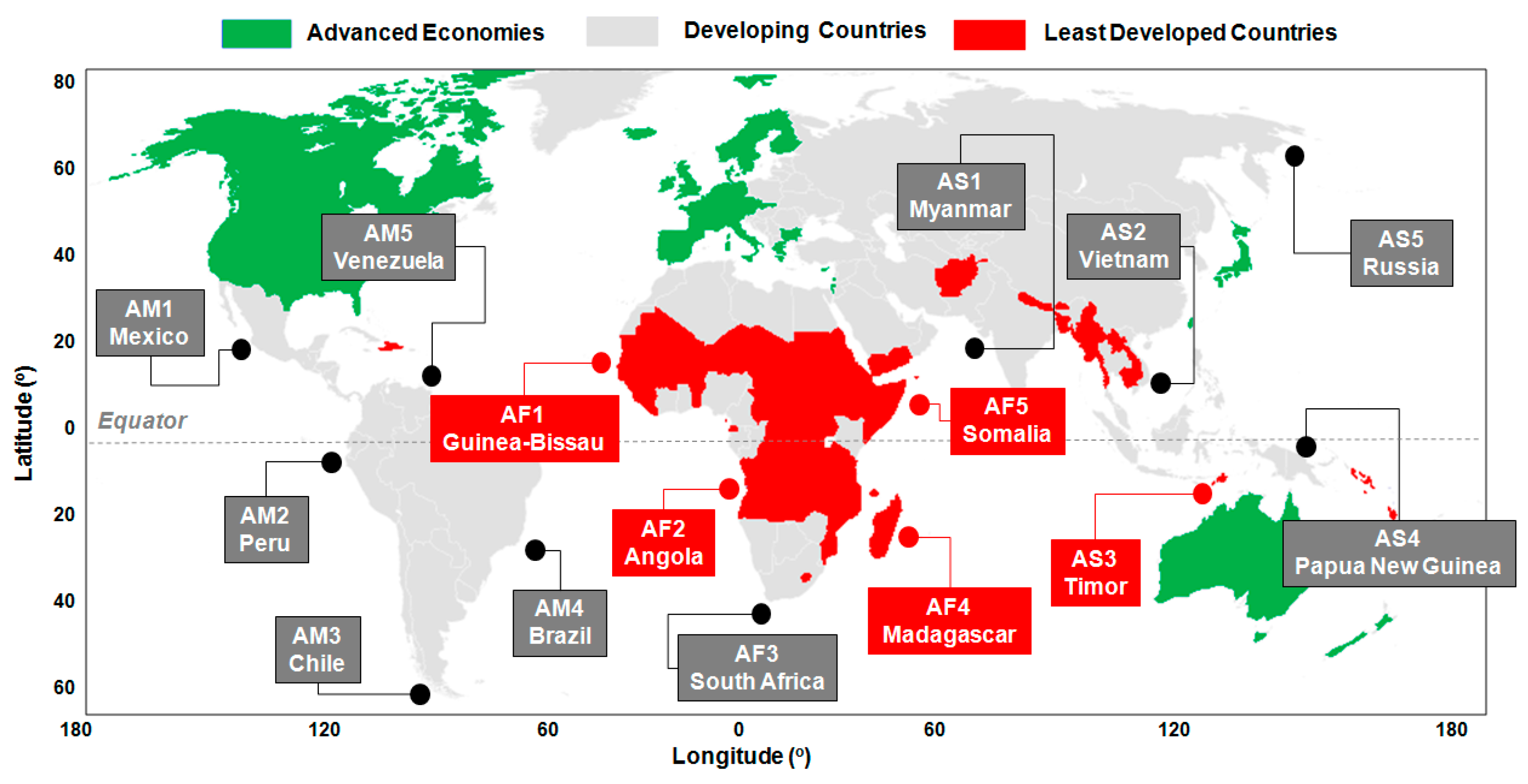
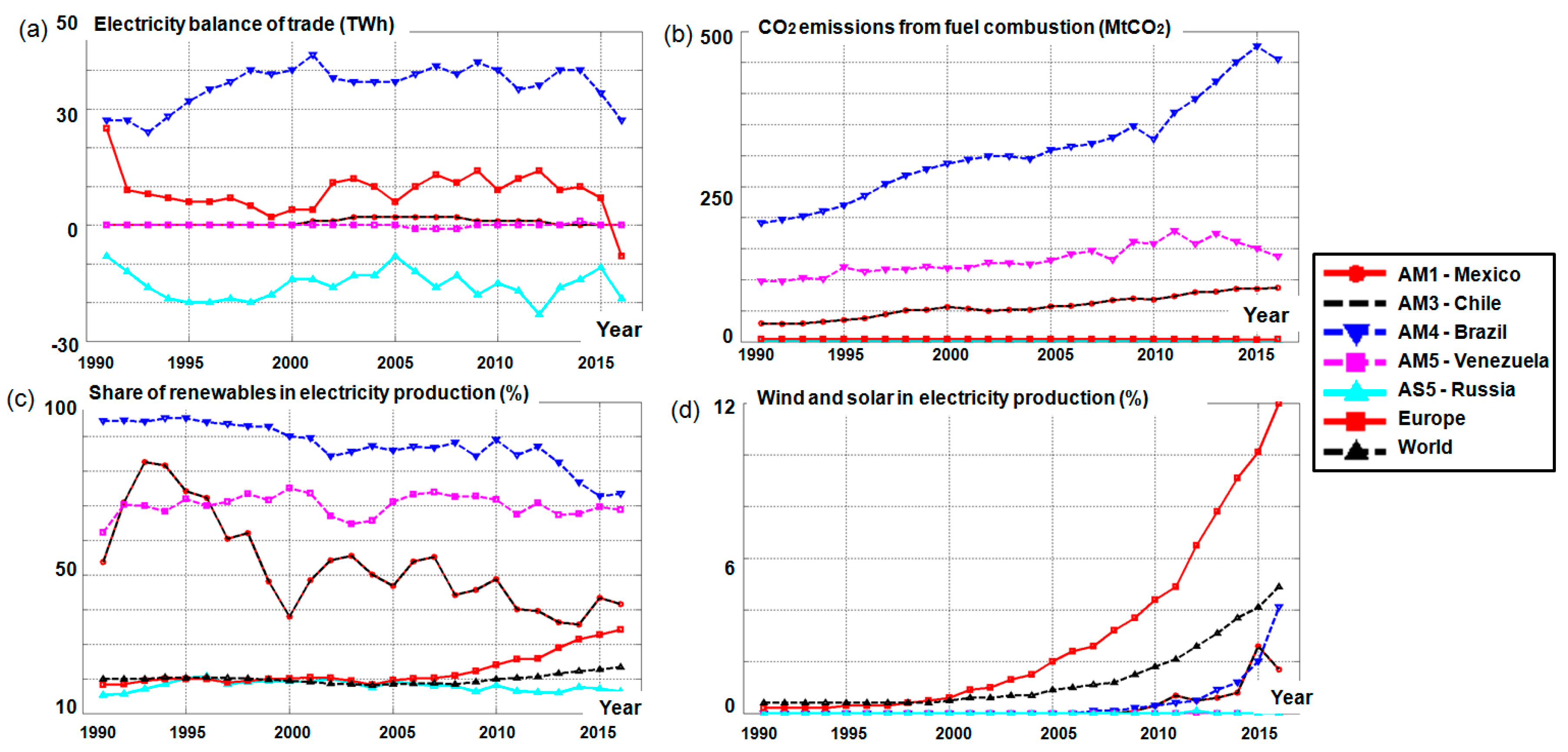
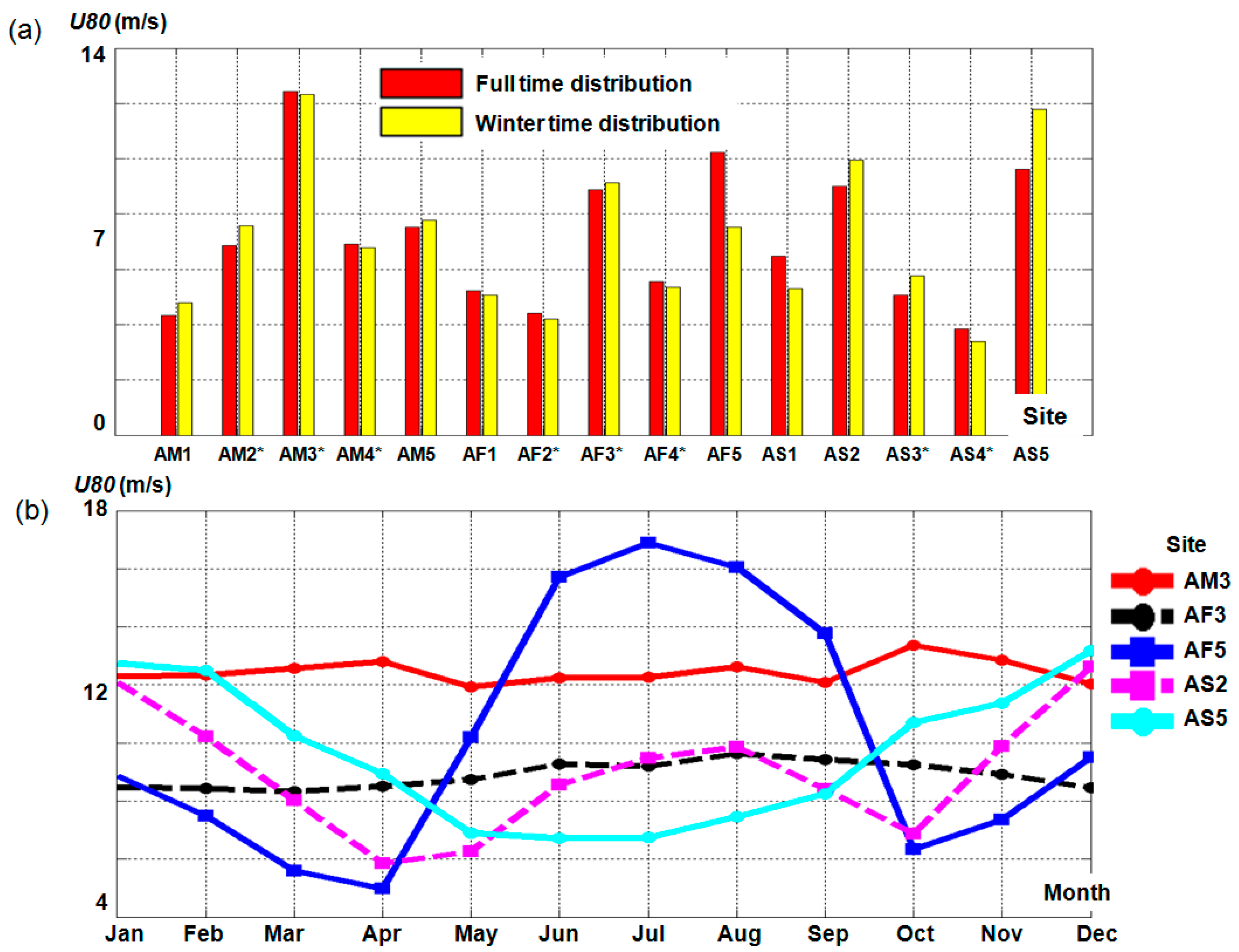
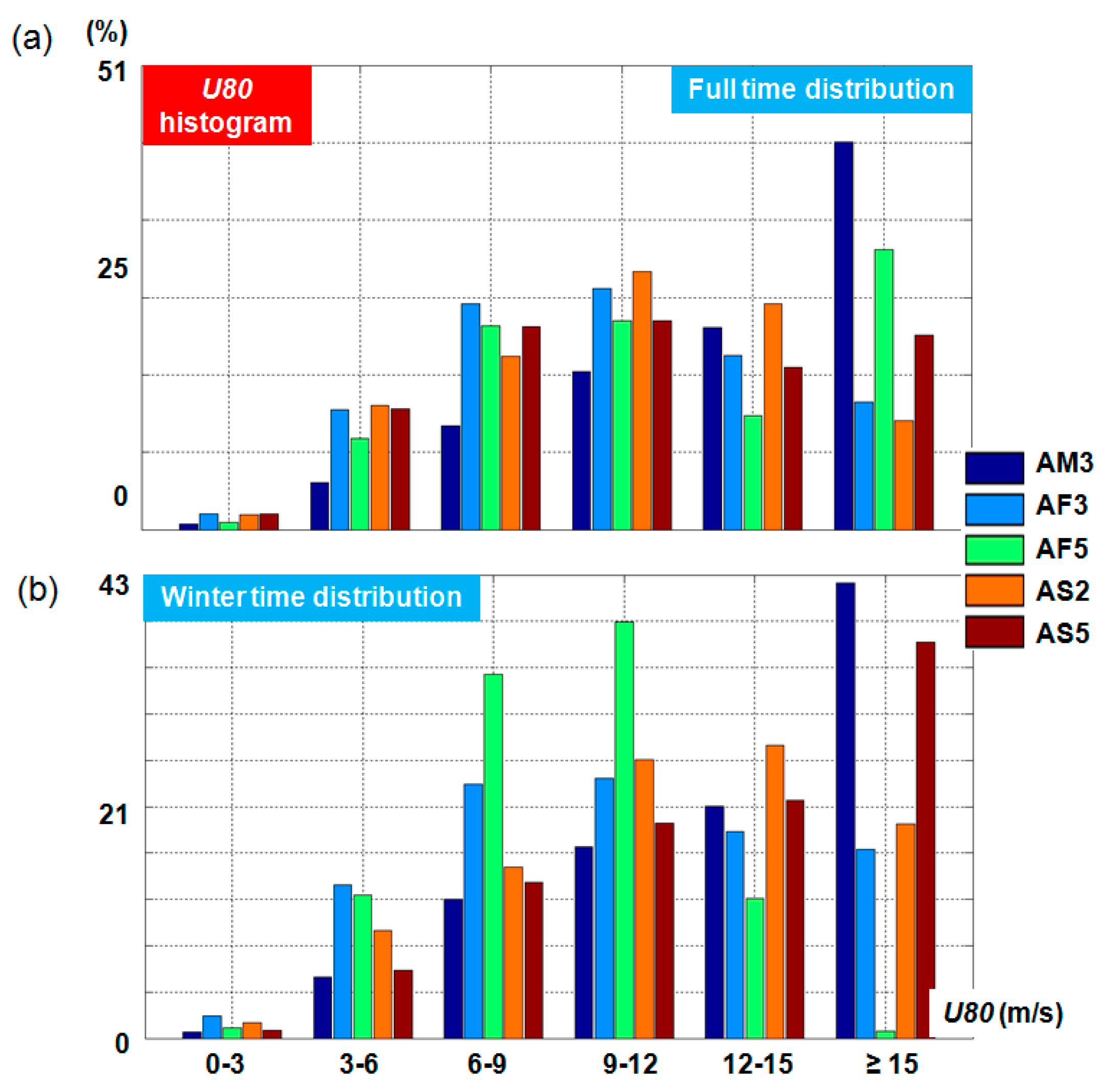
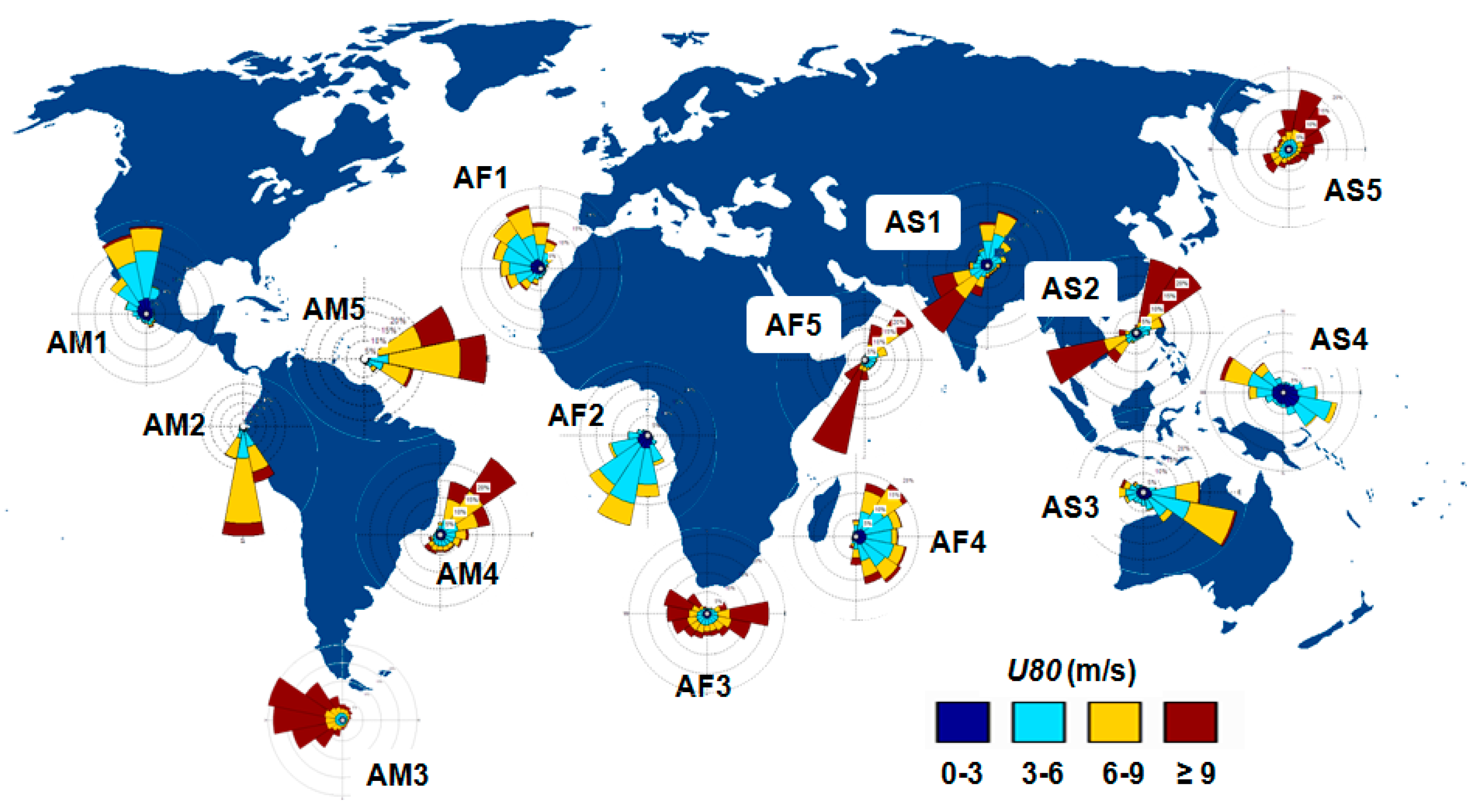
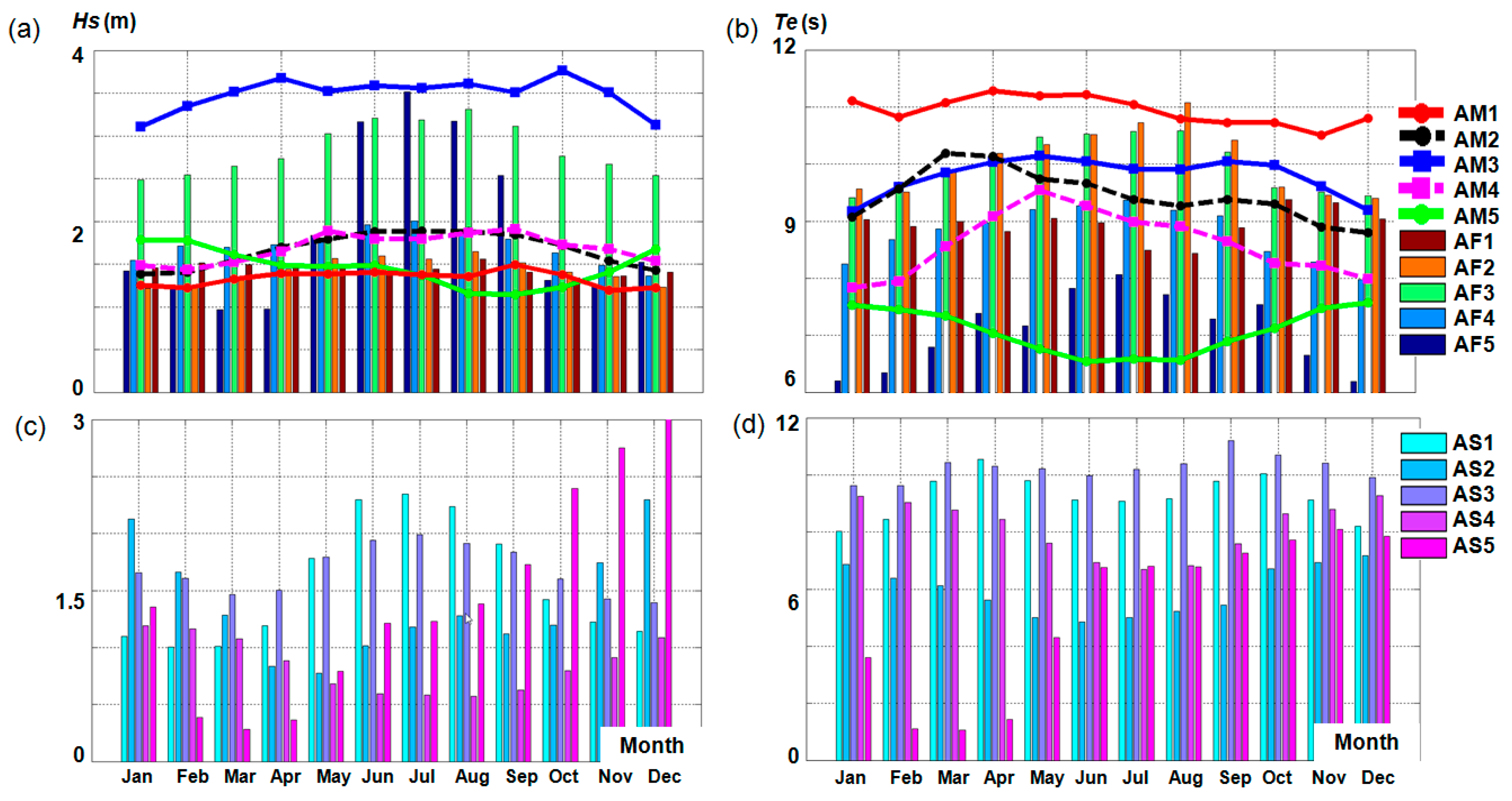
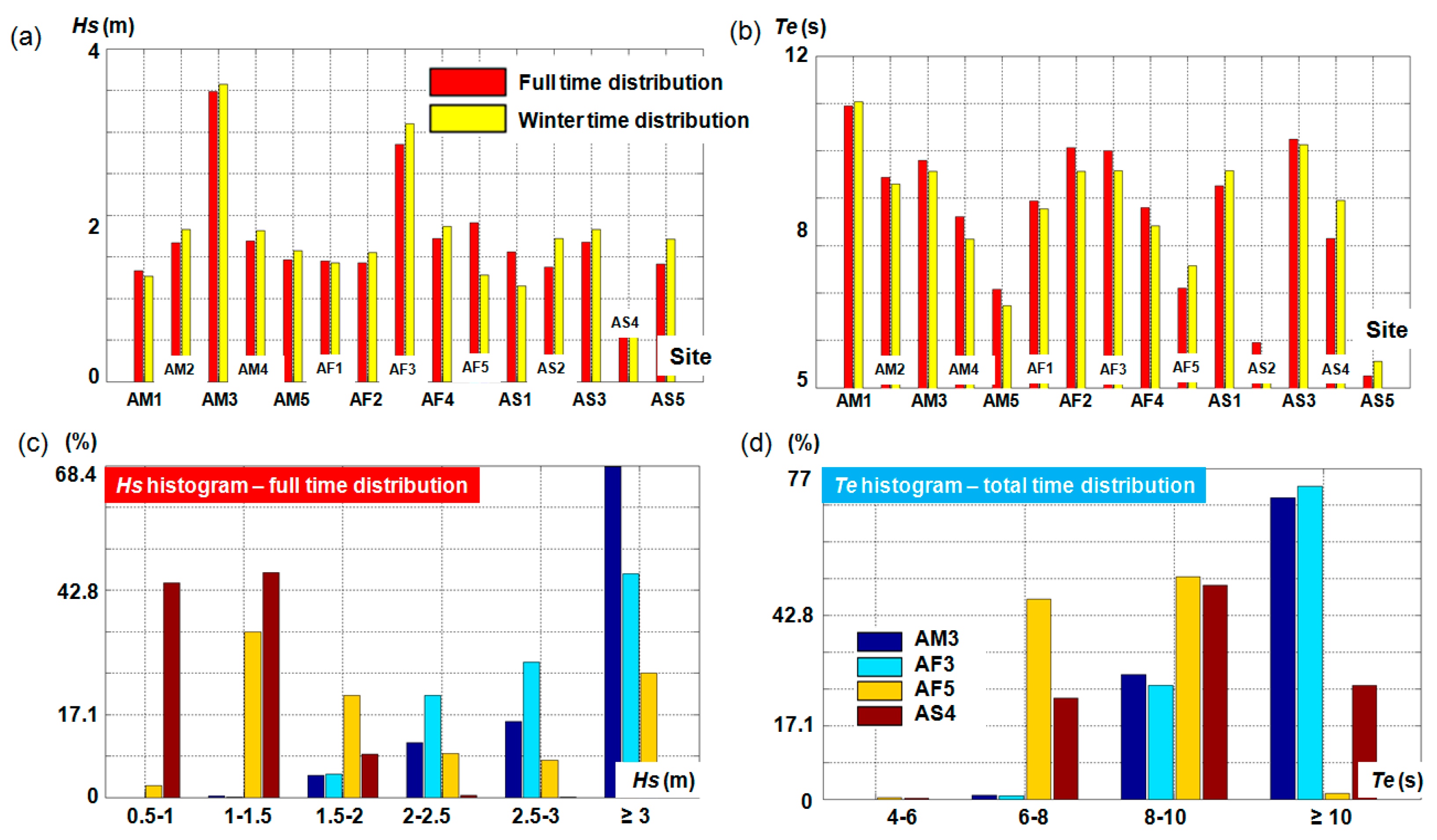
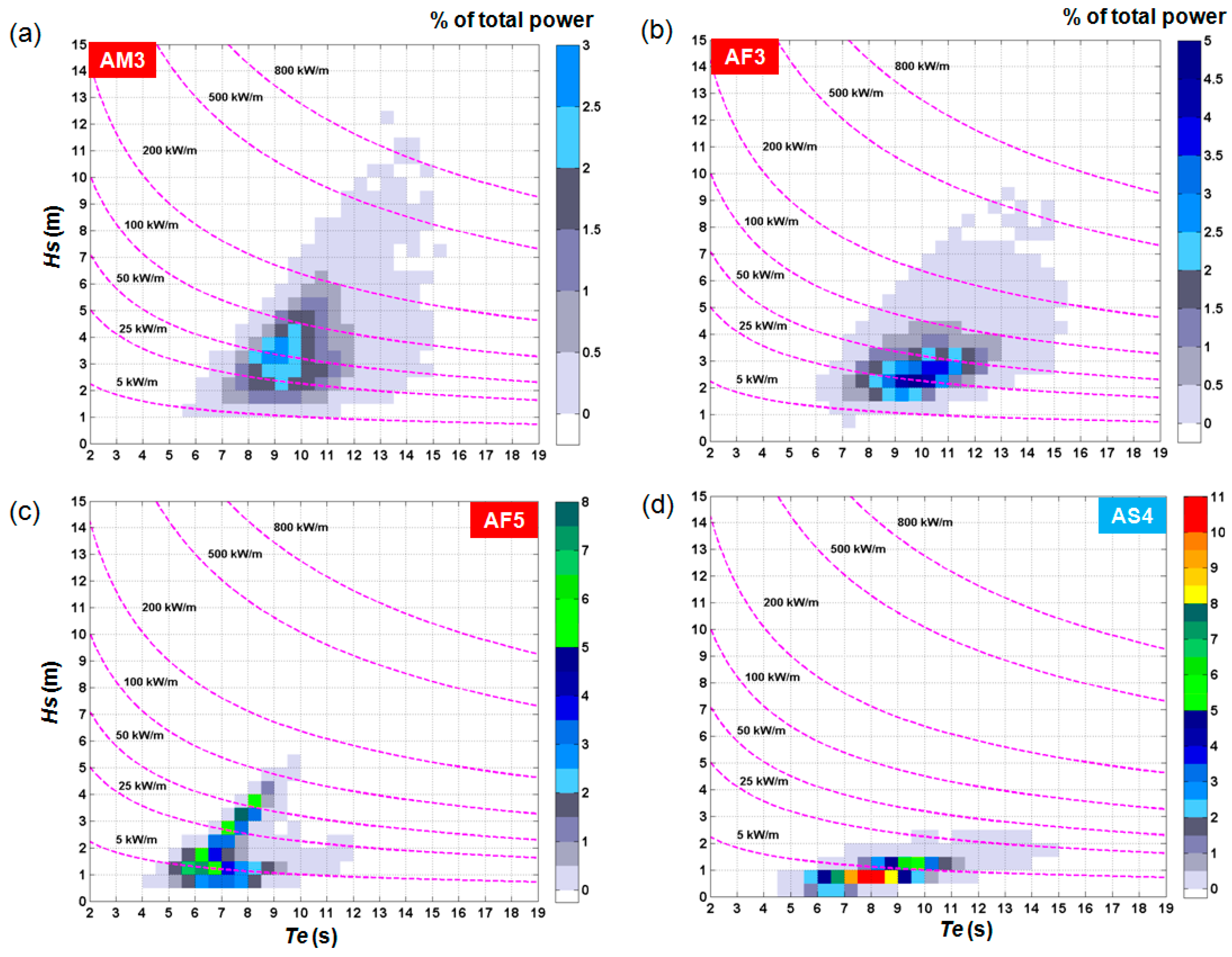
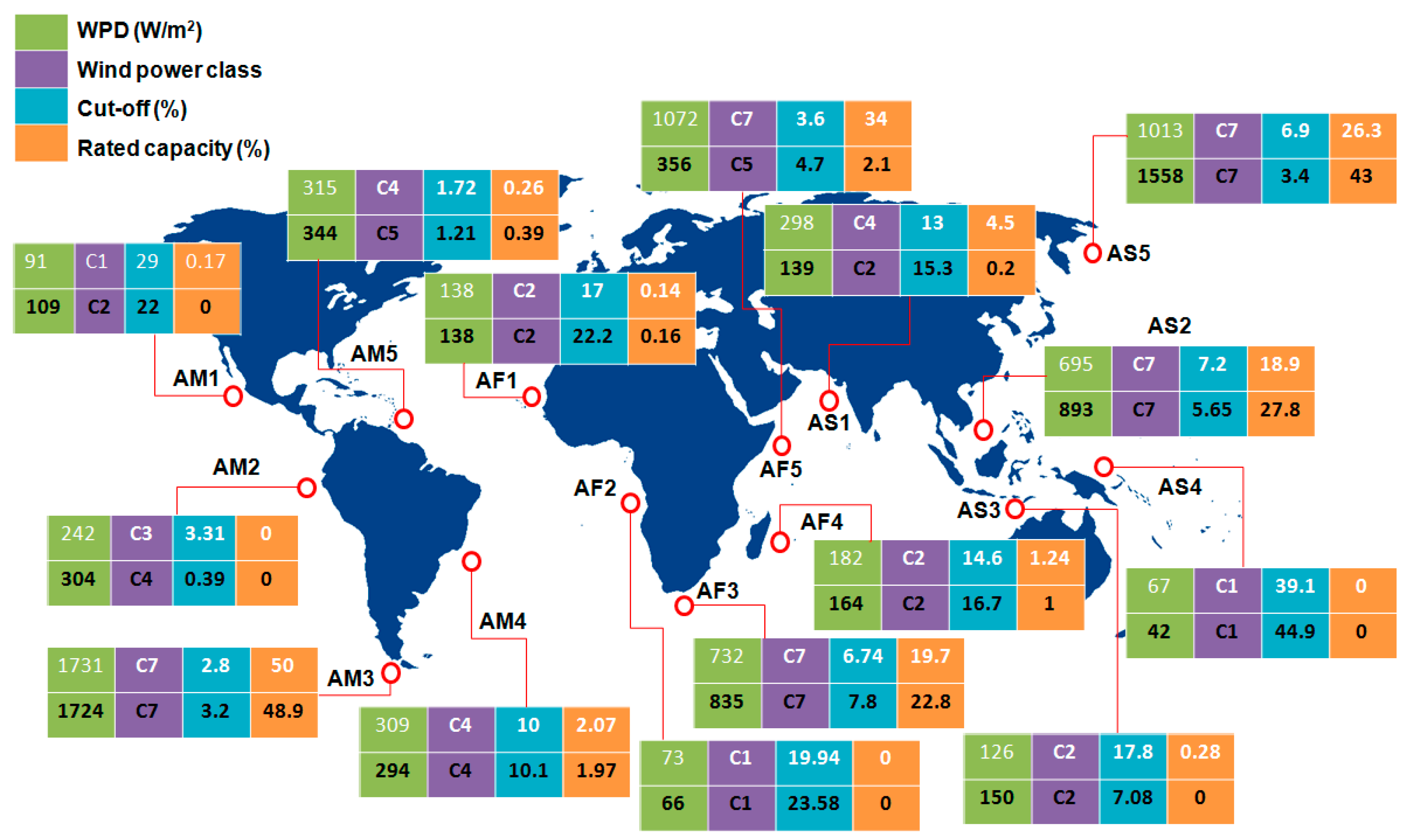
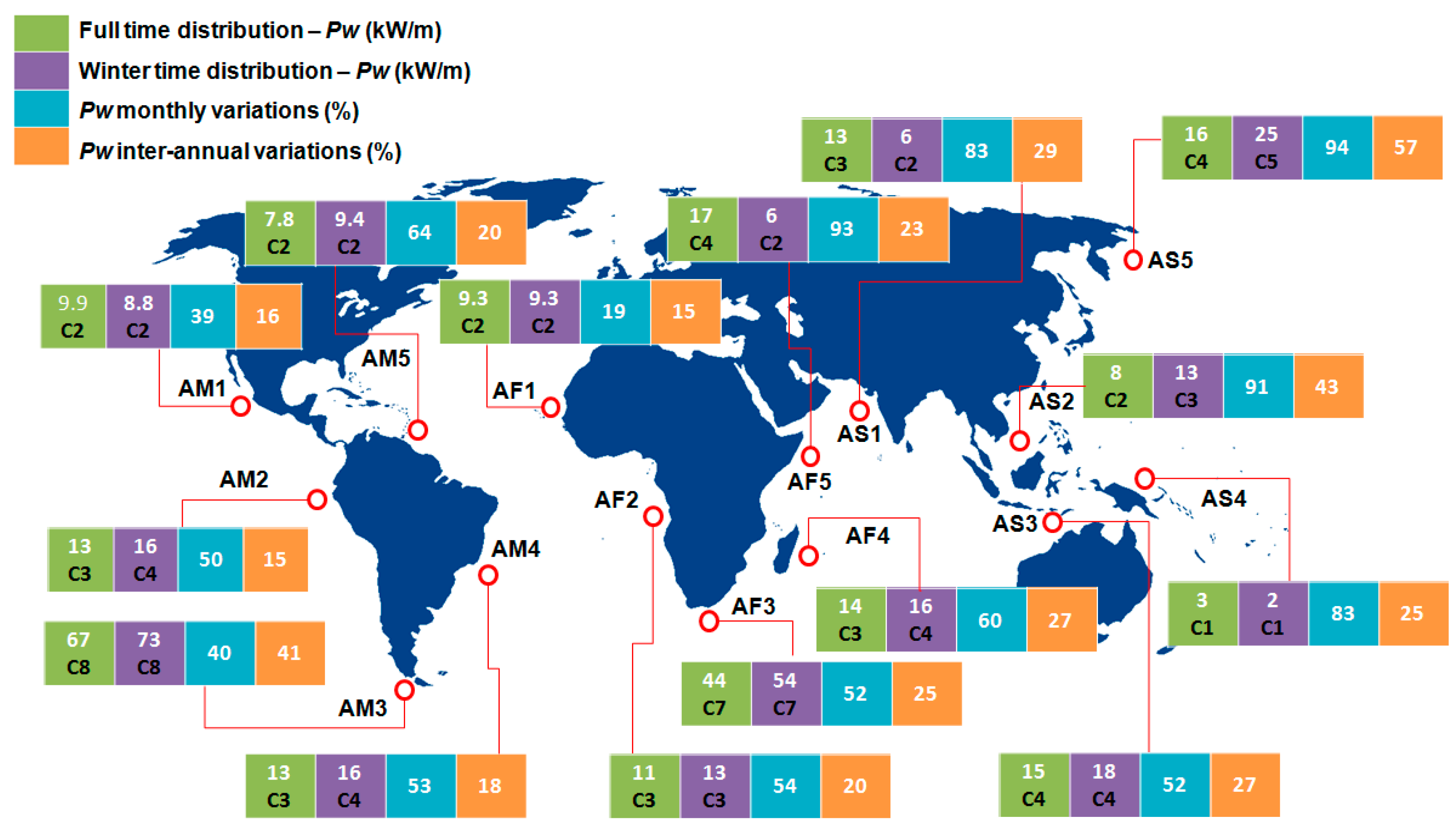

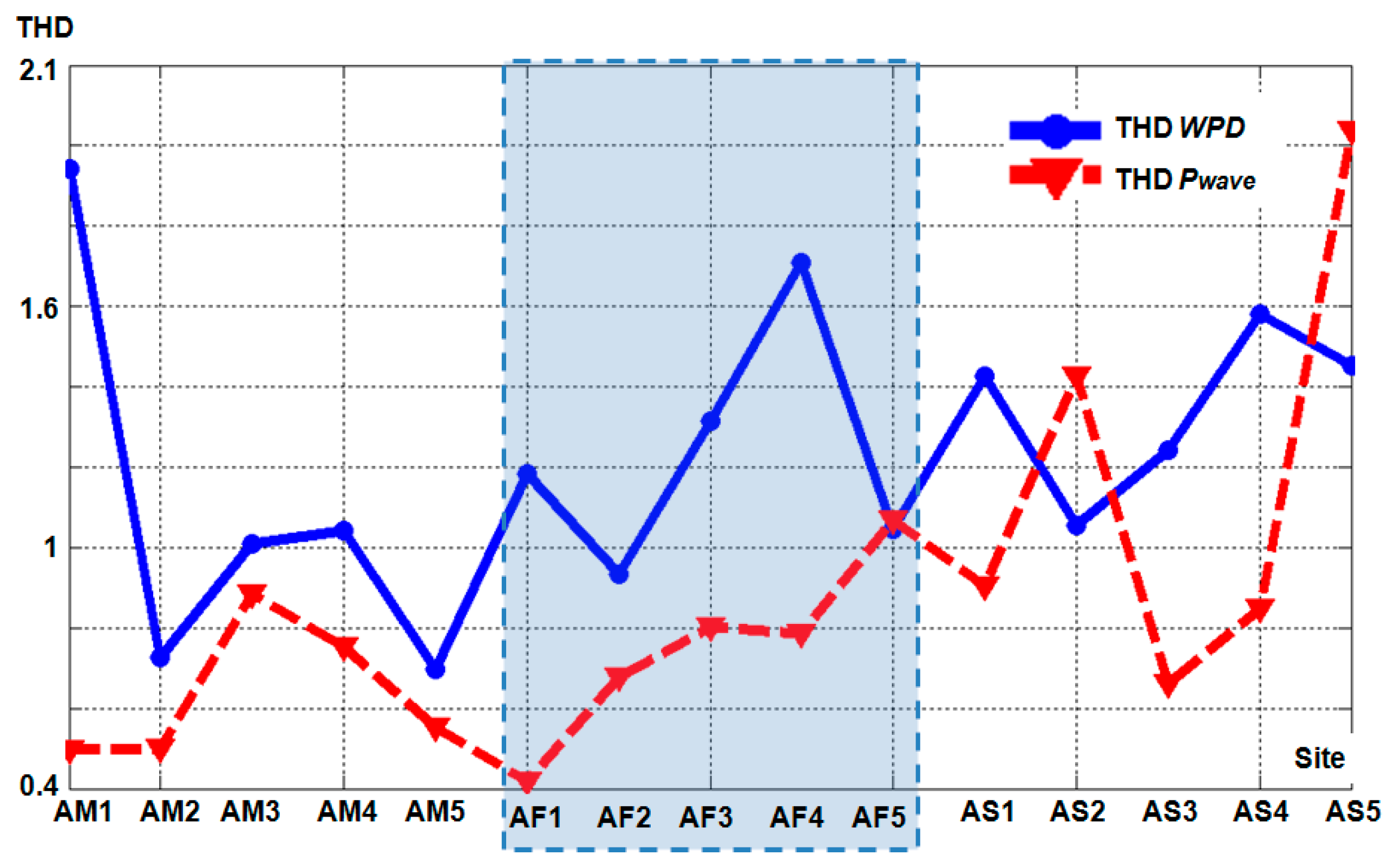
| Site → | AM1 | AM2 AM3 | AM4 | AM5 | AF1 | AF2 AF3 AF4 | AF5 | AS1 | AS2 | AS3 | AS5 | EU | World |
|---|---|---|---|---|---|---|---|---|---|---|---|---|---|
| Stat ↓ | |||||||||||||
| EBT (TWh) | 0 | 1 | 36 | 0 | 0 | 1 | 0 | 4 | 0 | 0 | −16 | 9 | - |
| TBT (Mtoe) | −60 | 18 | 37 | −140 | −111 | −24 | −12 | 40 | −21 | −122 | −450 | 777 | - |
| CO2 intensity (kCO2/$2005p) | 0.29 | 0.29 | 0.16 | 0.36 | 0.07 | 0.77 | 0.24 | 0.31 | 0.35 | 0.24 | 1.03 | 0.3 | 0.42 |
| Renewable (%) | 18.3 | 58.3 | 87.8 | 70.2 | 31.2 | 1.9 | 15.7 | 7.4 | 9.6 | 14.9 | 18 | 22.3 | 20 |
| Wind & solar (%) | 3.3 | 0.3 | 0.4 | 0 | 0 | 0.1 | 0.4 | 0.2 | 0 | 4.4 | 0 | 3 | 1.3 |
| Site | Mean WPD (W/m2) | Wind Power Classes (%) at a Height of 80 m * | ||||||
|---|---|---|---|---|---|---|---|---|
| C1 | C2 | C3 | C4 | C5 | C6 | C7 | ||
| AM1 | 91.42 | 73.41 | 14.33 | 4.17 | 3.06 | 1.71 | 1.67 | 1.64 |
| AM2 | 242.4 | 23.86 | 24.35 | 13.24 | 12.01 | 8.89 | 9.56 | 8.08 |
| AM3 | 1731 | 9.39 | 5.18 | 2.70 | 3.07 | 2.78 | 4.60 | 72.27 |
| AM4 | 309.2 | 34.24 | 15.31 | 7.13 | 7.33 | 5.95 | 8.79 | 21.25 |
| AM5 | 315.3 | 16.36 | 19.24 | 11.41 | 12.05 | 10.29 | 13.37 | 17.28 |
| AF1 | 137.6 | 57.78 | 18.81 | 7.12 | 5.35 | 3.77 | 3.71 | 3.46 |
| AF2 | 73.3 | 75.82 | 18.49 | 3.53 | 1.47 | 0.47 | 0.17 | 0.05 |
| AF3 | 732 | 23.08 | 11.5 | 5.38 | 5.57 | 4.85 | 7.07 | 42.54 |
| AF4 | 181.7 | 54.88 | 18.56 | 6.14 | 5.14 | 3.53 | 4.14 | 7.61 |
| AF5 | 1073 | 18.53 | 10.06 | 4.71 | 4.96 | 4.00 | 6.67 | 51.09 |
| AS1 | 297.3 | 43.59 | 16.58 | 6.34 | 5.52 | 4.11 | 5.59 | 18.27 |
| AS2 | 695.5 | 21.28 | 8.72 | 4.467 | 5.03 | 4.67 | 7.43 | 48.4 |
| AS3 | 125.2 | 59.11 | 21.23 | 7.2 | 5.04 | 2.78 | 2.40 | 2.24 |
| AS4 | 67.31 | 80.75 | 10.71 | 2.87 | 2.16 | 1.24 | 1.39 | 0.88 |
| AS5 | 1013 | 22.7 | 10.03 | 4.75 | 4.94 | 4.10 | 6.19 | 47.27 |
| Site | Hs (m) | Hs-95th (m) | <1 m (%) | Te (s) | Te-95th (s) | Pw (kW/m) | Pw-95th (kW/m) |
|---|---|---|---|---|---|---|---|
| AM1 | 1.33 | 1.81 | 6.49 | 10.9 | 13 | 9.87 | 19 |
| AM2 | 1.67 | 2.27 | 0.36 | 9.45 | 11.6 | 13.4 | 26.4 |
| AM3 | 3.49 | 5.81 | 0 | 9.79 | 12 | 67.5 | 177 |
| AM4 | 1.69 | 2.57 | 1.57 | 8.61 | 11.1 | 13.4 | 32.9 |
| AM5 | 1.46 | 2.08 | 5.93 | 7.07 | 8.6 | 7.81 | 16.2 |
| AF1 | 1.45 | 1.88 | 1.31 | 8.94 | 10.8 | 9.31 | 16.7 |
| AF2 | 1.42 | 2.08 | 6.4 | 10.1 | 12.5 | 10.9 | 25.3 |
| AF3 | 2.85 | 4.52 | 0 | 10 | 12.5 | 44.4 | 111 |
| AF4 | 1.72 | 2.53 | 0.8 | 8.8 | 10.6 | 13.8 | 29.5 |
| AF5 | 1.91 | 3.69 | 16.6 | 7.1 | 8.6 | 16.8 | 54 |
| AS1 | 1.56 | 2.83 | 19.2 | 9.26 | 11.8 | 12.6 | 34.9 |
| AS2 | 1.38 | 2.93 | 37.1 | 5.95 | 8.3 | 8.3 | 32.5 |
| AS3 | 1.68 | 2.5 | 3.26 | 10.3 | 12.9 | 15.2 | 34.4 |
| AS4 | 0.85 | 1.37 | 70.7 | 8.15 | 10.3 | 3.39 | 8.73 |
| AS5 | 1.41 | 4.07 | 42.4 | 5.25 | 9.6 | 15.8 | 72.1 |
| Site | U80 Monthly Variations (%) | U80 Inter-Annual Variations (%) | Hs Monthly Variations (%) | Hs Inter-Annual Variations (%) |
|---|---|---|---|---|
| AM1 | 35.04 | 19.3 | 20.15 | 6.577 |
| AM2 | 39.4 | 22.98 | 26.9 | 8.075 |
| AM3 | 10.75 | 14.24 | 17.57 | 18.91 |
| AM4 | 26.41 | 9.77 | 24.77 | 6.206 |
| AM5 | 32.52 | 17.48 | 36.1 | 12.6 |
| AF1 | 49.91 | 8.779 | 14.3 | 5.09 |
| AF2 | 26.97 | 9.68 | 25.96 | 8.202 |
| AF3 | 13.51 | 13.19 | 24.94 | 11.91 |
| AF4 | 17.19 | 9.591 | 31.99 | 10.74 |
| AF5 | 70.44 | 7.938 | 72.46 | 8.563 |
| AS1 | 62.12 | 10.73 | 57.18 | 11.08 |
| AS2 | 53.52 | 23.02 | 66.26 | 24.81 |
| AS3 | 42.51 | 15.53 | 30.08 | 11.48 |
| AS4 | 41.36 | 21.72 | 51.94 | 8.852 |
| AS5 | 49.03 | 16.31 | 90.57 | 47.83 |
© 2017 by the authors. Licensee MDPI, Basel, Switzerland. This article is an open access article distributed under the terms and conditions of the Creative Commons Attribution (CC BY) license (http://creativecommons.org/licenses/by/4.0/).
Share and Cite
Rusu, E.; Onea, F. Joint Evaluation of the Wave and Offshore Wind Energy Resources in the Developing Countries. Energies 2017, 10, 1866. https://doi.org/10.3390/en10111866
Rusu E, Onea F. Joint Evaluation of the Wave and Offshore Wind Energy Resources in the Developing Countries. Energies. 2017; 10(11):1866. https://doi.org/10.3390/en10111866
Chicago/Turabian StyleRusu, Eugen, and Florin Onea. 2017. "Joint Evaluation of the Wave and Offshore Wind Energy Resources in the Developing Countries" Energies 10, no. 11: 1866. https://doi.org/10.3390/en10111866
APA StyleRusu, E., & Onea, F. (2017). Joint Evaluation of the Wave and Offshore Wind Energy Resources in the Developing Countries. Energies, 10(11), 1866. https://doi.org/10.3390/en10111866







